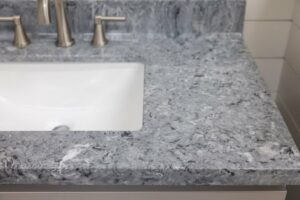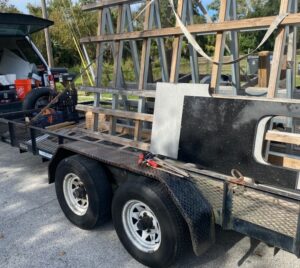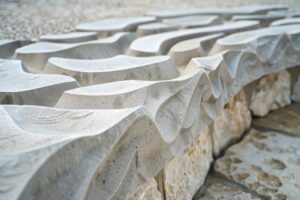Living in Florida means embracing a lifestyle where sun, sand, and sea are part of your daily rhythm. It’s a beautiful existence, but it comes with a unique set of demands for our homes. The salty air, relentless humidity, and brilliant sunshine that we love can be tough on building materials, especially in the most-used rooms of the house: the kitchen and bathrooms. As a Florida homeowner, you need surfaces that are not just beautiful but resilient—materials that offer a serene, coastal aesthetic without demanding constant upkeep.
For years, the countertop debate has swirled around a handful of key players, but as we look toward 2025 and 2026, one material continues to solidify its reign as the professional’s choice for coastal living: quartz. While the allure of natural stone like granite and marble is undeniable, engineered quartz is consistently recommended by designers, fabricators, and builders for its superior performance and design flexibility. In fact, the National Kitchen & Bath Association (NKBA) has consistently reported in its annual trend studies that quartz is the dominant countertop material, holding its top spot by a significant margin. For 2025, this trend isn’t just holding; it’s strengthening.
Why? Because quartz delivers on the promise of modern luxury: flawless beauty with minimal fuss. This guide is designed for the savvy, design-conscious Florida buyer. We’ll explore why quartz is perfectly suited for our unique climate, dive into the stunning color and design trends for 2025–2026, and cover the practical details of edges, care, and warranties. Consider this your essential roadmap to choosing a countertop that will look stunning today and for years to come.

Why Quartz Still Leads the Market (2025–2026)
The enduring popularity of quartz isn’t a fluke; it’s a direct result of its intelligent design. Unlike natural stone, which is quarried in massive, imperfect slabs, quartz countertops are an engineered product. They are typically composed of around 90-95% crushed natural quartz crystals—one of the hardest minerals on earth—blended with polymer resins and pigments. This mixture is then compacted into dense, nonporous slabs under intense pressure and heat.
This manufacturing process is the secret to its success. It gives quartz two critical advantages that Florida homeowners prize: unmatched consistency and superior strength.
1. Uniformity in Color and Pattern:
When you fall in love with a slab of granite or marble, you’re looking at a one-of-a-kind piece. While beautiful, this uniqueness can be a liability. The slab you see in the showroom might have veining, fissures, or color variations that you don’t like in the piece delivered to your home. With quartz, what you see is what you get. The engineering process ensures that the color, pattern, and texture are uniform throughout the slab and consistent from one slab to another. This is a massive benefit for large projects, like a kitchen with a waterfall island and a matching full-height backsplash, where a cohesive, seamless look is paramount.
2. Engineered for Durability:
The resins in quartz bind the crushed crystals together, creating a surface that is harder and more durable than many natural stones. It’s highly resistant to scratches, chips, and cracks from everyday use. According to a 2024 Houzz & Home survey, durability and ease of maintenance are among the top considerations for homeowners renovating their kitchens, and quartz excels in both areas. While granite is tough, it contains natural fissures that can be weak points, and marble is notoriously soft and prone to scratching and etching. Quartz, by contrast, is engineered to withstand the chaos of a busy family kitchen.
Quartz vs. Granite and Marble: The Maintenance Advantage
From a practical standpoint, the biggest differentiator is porosity. Granite and marble are porous stones, meaning they have tiny, microscopic holes that can absorb liquids. A spilled glass of red wine, a splash of lemon juice, or a drop of olive oil can quickly seep into the stone and cause a permanent stain if not wiped up immediately. To combat this, natural stone countertops require regular sealing—typically once a year—to protect them.
Quartz, on the other hand, is nonporous. The resin binders make the surface impermeable to liquids, so it will never absorb bacteria, wine, or oil. This means:
- No sealing, ever. This saves you time, money, and effort over the life of the countertop.
- Incredibly stain-resistant. Spills sit on the surface, waiting to be wiped away.
- Hygienic. The nonporous surface won’t harbor bacteria, mold, or mildew—a significant advantage in Florida’s humid climate.
For the modern homeowner who values both form and function, the choice is clear. Quartz delivers the high-end, luxurious look of natural stone without the associated maintenance headaches, making it the undisputed champion for 2025 and beyond.
Florida’s 2025–2026 Quartz Color Trends
The design world is moving away from the cool, stark grays that dominated the last decade and embracing warmer, more organic palettes. This shift is perfectly aligned with Florida’s coastal lifestyle, which celebrates nature, light, and tranquility. For 2025–2026, quartz manufacturers are leaning into this with sophisticated colors and textures that evoke the state’s natural beauty.
Coastal Minimalism: Soft Whites and Subtle Veining
The all-white kitchen remains a timeless classic, but the trend for 2025–2026 is about adding warmth and subtlety. Think less sterile operating room and more serene seaside retreat.
- Colors: Look for quartz in shades of cloud white, soft linen, and warm alabaster. The key is in the veining—delicate, feathery veins in soft gray, greige, or even a faint gold are incredibly popular. These designs mimic the look of classic Calacatta or Carrara marble but offer a softer, more understated elegance.
- Why it works for Florida: These light, airy colors reflect our abundant sunshine, making kitchens and baths feel larger and brighter. They create a clean, calm backdrop that pairs beautifully with natural woods, woven textures, and pops of coastal color.
- Popular Looks: Brands like Caesarstone (e.g., Calacatta Nuvo or Statuario Maximus) and Cambria (e.g., Brittanicca Gold or Ironsbridge) are masters of this style.
Warm Neutrals: Sand Tones and Earthy Greiges
To complement the move toward warmer cabinetry and finishes, neutral quartz countertops are shifting from cool grays to inviting beiges, taupes, and greiges (a mix of gray and beige).
- Colors: Picture the shades of wet sand, weathered driftwood, or smooth river stones. These colors have an earthy, grounding quality that feels both modern and timeless. They often feature subtle, tone-on-tone marbling or a softly mottled appearance rather than dramatic veins.
- Texture Options: This is where texture plays a huge role. A matte or honed finish on a sandy-toned quartz can create an incredibly organic, beachy feel. Some manufacturers even offer a “concrete” finish, which has a slight texture that adds depth and an industrial-chic touch, perfect for a contemporary coastal home.
- Why it works for Florida: These tones are masters of hiding the occasional grain of sand tracked in from the beach and provide a forgiving, easy-to-live-with surface. They bridge the gap between crisp whites and darker accents, offering a sophisticated and welcoming palette.
Statement Islands: Sea-Glass Blues and Dramatic Greens
While neutral perimeters remain popular, the kitchen island is increasingly being treated as a piece of statement furniture. Homeowners are getting bolder, using the island to introduce color and personality.
- Colors: Think of the deep, moody blues of the Gulf of Mexico, the soft, translucent greens of sea glass, or even rich emeralds. These colors are often showcased in quartz designs with dramatic, sweeping veins of white, gold, or charcoal that mimic the movement of waves.
- How to Use Them: A bold, colorful quartz on the island, paired with quiet, neutral countertops along the perimeter, creates a stunning focal point without overwhelming the space. This “tuxedo kitchen” approach (dark island, light perimeters) is a designer favorite for 2025.
- Why it works for Florida: It’s a direct nod to our environment. These colors connect the home’s interior to the stunning natural landscapes just outside the door, creating a cohesive and deeply personal design.

Edges & Design Details
The edge profile you choose for your quartz countertop is a small detail that makes a big impact on the overall style and cost of your project. Florida showrooms are seeing a clear preference for clean, contemporary lines that complement modern coastal design.
1. Eased Edge:
This is by far the most popular choice for its simplicity and versatility. An eased edge is a squared edge with the sharp corners slightly rounded (or “eased”) to prevent chipping and injuries. It’s clean, unobtrusive, and works with virtually any design style, from transitional to ultra-modern. It’s also typically a standard edge, meaning it doesn’t add to the fabrication cost.
2. Mitered Edge:
A mitered edge is a technique used to create the illusion of a much thicker slab of quartz. The fabricator cuts the top piece and the edge piece at 45-degree angles and joins them together, creating a seamless corner. This allows you to have a countertop that looks like it’s 2, 3, or even 4 inches thick, which is a very high-end, luxurious look. It’s perfect for creating a substantial, weighty feel on a kitchen island. This is a premium edge and will add to the fabrication cost.
3. Waterfall Edge:
The waterfall edge is the ultimate statement in modern kitchen design. This is where the countertop material continues down the side of the cabinet or island, all the way to the floor. It creates a continuous, flowing look that is incredibly dramatic and sophisticated. It’s a perfect way to showcase a quartz slab with beautiful, dynamic veining. Like the mitered edge, this is a premium option that requires expert fabrication and significantly increases the cost, but the visual impact is unmatched.
How Edges Influence Cost and Style:
- Cost: Standard edges like eased or a small bevel are usually included in the base price per square foot. More complex, decorative edges (like ogee or bullnose, which are becoming less popular) or premium edges (mitered, waterfall) require more labor and material, increasing the final price.
- Style: Clean, simple edges (eased) lend themselves to a contemporary or minimalist aesthetic. A mitered edge adds a sense of luxury and substance. A waterfall edge is a bold, architectural statement.
Care, Cleaning & Maintenance
One of the top reasons quartz countertops are a pro favorite in Florida is their incredible ease of care. The low-maintenance appeal is a perfect fit for a relaxed, coastal lifestyle.
The Golden Rules of Quartz Care:
- Simple Cleaning: For daily cleaning, a soft cloth or sponge with warm water and a drop of mild dish soap is all you need. Wipe the surface down and dry it with a microfiber cloth to prevent water spots.
- No Harsh Chemicals: Avoid abrasive cleaners, scouring pads, and harsh chemicals like bleach, oven cleaner, or drain cleaner. These can dull the polished surface or damage the resins.
- Nonporous Advantage: Because quartz is nonporous, it doesn’t need to be sealed. Ever. This is a huge selling point compared to natural stone.
Florida-Specific Care Tips:
- Humidity and Mildew: While quartz itself is resistant to mold and mildew, the seams (where two pieces of quartz are joined) or the caulking around the sink and backsplash can be susceptible in our humid climate. Be sure to wipe these areas dry regularly to prevent mildew growth.
- Beach Residue: Sand is quartz! Fine grains of sand on a sponge or cloth can act like sandpaper and create fine scratches or dull the finish over time. Always rinse your countertops with plain water to remove any gritty residue before cleaning with soap.
- UV Exposure Near Windows: Quartz countertops are generally UV-stable, but prolonged, direct exposure to intense sunlight over many years can potentially cause slight fading or discoloration, especially in darker colors. If you have a countertop under a large, south-facing window that gets direct sun all day, consider using blinds or a UV-blocking window film to be safe. Most major brands, however, warranty their products against this for indoor use.
Warranties & What to Check Before You Buy
Reputable quartz manufacturers stand behind their products with impressive warranties, typically ranging from 10 years to a limited lifetime warranty. However, a warranty is only as good as its terms, so it’s crucial to understand what is and isn’t covered.
Understanding Your Warranty:
- Length and Transferability: Most top-tier brands (Cambria, Caesarstone, Silestone) offer warranties of 15-25 years or even a limited lifetime warranty for the original owner. Some warranties are transferable to the next homeowner, which can be a nice selling point for your house, while others are not. Be sure to ask.
- What’s Covered: Warranties typically cover manufacturing defects in the material itself. This could include issues like unusual discoloration, cracks that appear without impact, or problems with the slab’s composition.
- What Voids a Warranty: This is the most important part. Warranties are almost always voided by:
- Heat Damage: The resins in quartz can be damaged by extreme heat. Placing a hot pan directly from the stove or oven onto the countertop can cause thermal shock, resulting in a crack or a permanent burn mark. Always use trivets or hot pads.
- Improper Installation: DIY installation or using a non-certified installer will almost certainly void your warranty. The manufacturer’s warranty covers the material; your fabricator/installer should warranty their workmanship.
- Chemical Damage: Using harsh chemicals, abrasive cleaners, or unapproved cleaning products will void the warranty.
- Outdoor Use: Unless the product is specifically rated for outdoor use (a newer, specialized category), installing standard quartz outside will void the warranty.
Checklist: What to Ask Your Installer or Showroom Rep
Before you sign on the dotted line, have this list of questions ready:
- Is this a first-quality slab, or is it from a remnant or commercial grade?
- What is the manufacturer’s warranty on the material, and can I get a copy of it? Is it transferable?
- What is your warranty on the installation and fabrication? (Ask about seams, sink installation, etc.)
- How many seams will my project require, and where will you place them? (A good fabricator will plan seams to be as inconspicuous as possible.)
- Does the price include measurement, fabrication, delivery, installation, and sink cutout?
- Are you licensed and insured in the state of Florida?
Your New Countertop Awaits
Choosing a new countertop is one of the biggest decisions you’ll make in your kitchen or bath remodel. It’s a surface you’ll see, touch, and use every single day. By prioritizing the engineered consistency, superior durability, and effortless maintenance of quartz, you’re investing in a surface that is perfectly tailored to the demands and beauty of the Florida lifestyle. With the stunning new colors and textures available for 2025–2026, you don’t have to compromise between practicality and breathtaking design.
Ready to see Florida’s newest quartz colors in person? The depth of the colors, the feel of the finishes, and the subtle beauty of the veining are best appreciated up close.





